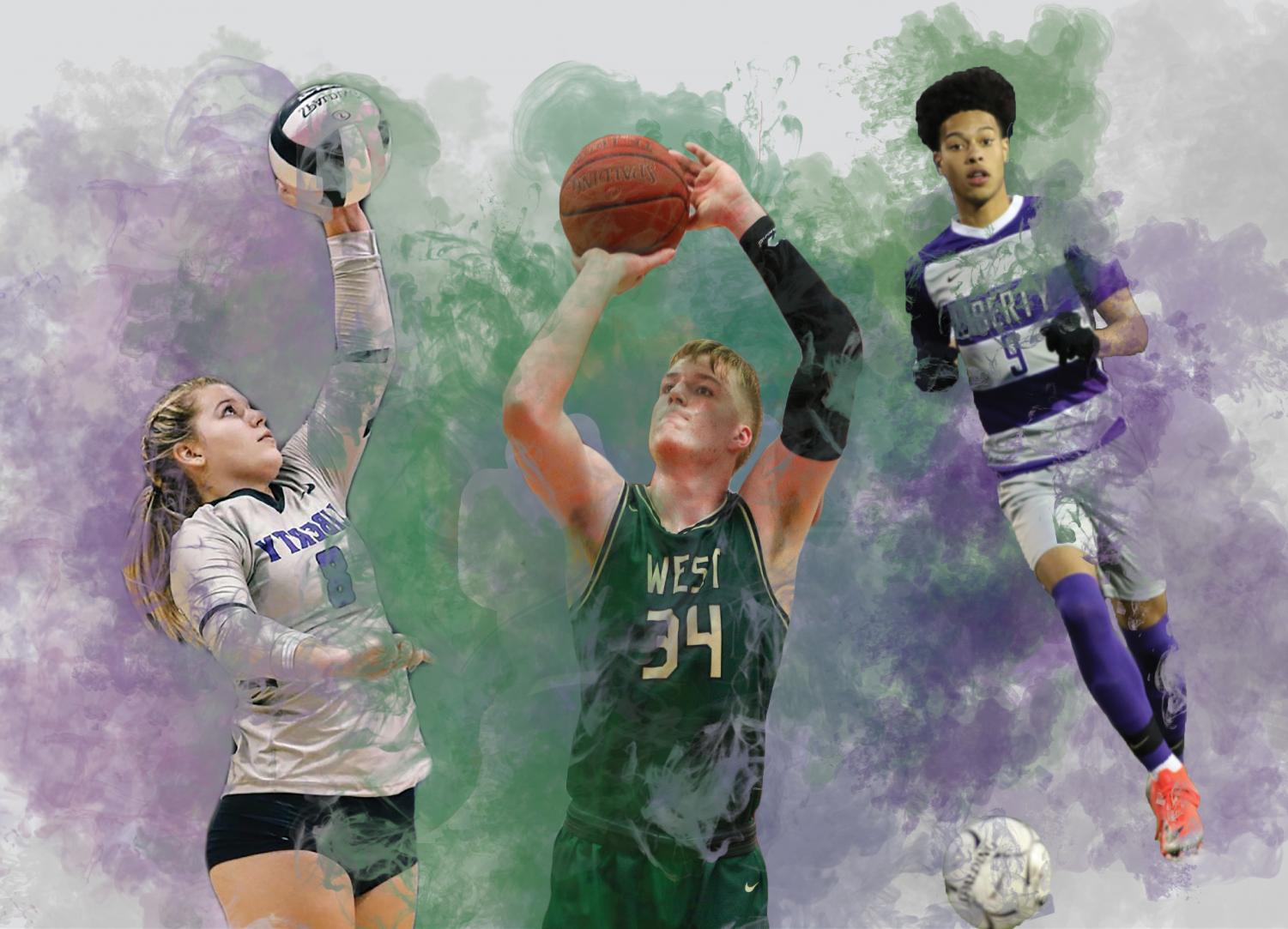Your donation will support the student journalists of West High School. Your contribution will allow us to purchase Scholarship Yearbooks, newsroom equipment and cover our annual website hosting costs.
Transfers on the rise for West athletics
A recent increase in student-athletes transferring from Liberty to West has warranted a deeper look into the complex reasons and logistics for athletes transferring schools across the state of Iowa.
March 5, 2020
It’s almost an unspeakable phrase in Iowa high school sports: transfer.
Whenever a student-athlete transfers to a new school, particularly without changing their residence, rumors and speculations inevitably begin to circulate. The word “transfer” itself conjures up accusations of recruiting and misconduct that can blemish the reputation of an athlete seeking a better opportunity at a once rival school.
More often than not, however, a student athlete’s decision to transfer schools is the result of multiple factors. Coaching styles, college development or simply wanting a fresh start are all reasons for high school athletes to transfer to a new school.
Like most states in the US, the Iowa High School Athletic Association and the Iowa High School Girls Athletic Union do not grant immediate athletic eligibility for every student that transfers. There are three main types of transfer student-athletes West High encounters, each with their own nuances and regulations.
Relocation
West has always been an attractive school for out-of-state and in-state transfers looking to better their academic and athletic careers. The recent success of West High’s athletic programs coupled with the high-achieving academic performance of its students has drawn athletes like varsity defensive end and wrestler Anu Dokun ’20 to wear the green and gold.
“We looked at the schools [in the ICCSD] and started touring a couple of them,” said Dokun, who is originally from Memphis. “For my thing, it was who had the best football team and West [had] been to the playoffs the last few years.”
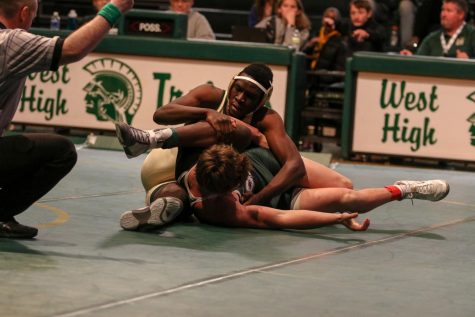
Newcomer Anu Dokun ’20 fights for position during his 195 pound match against Adam Ward ’21. Dokun fought back from a 7-3 deficit to force an extra period, but ultimately fell 11-9. Dokun transferred to West from Memphis for the beginning of his senior year.
For these students, transferring into West is a simple process. As long as the student’s family physically moves and relocates into the West attendance area and can complete the required eligibility checklist proving their residence, the student is immediately eligible for varsity athletics.
This rule also applies to students already living in Iowa. If a student moves into the West attendance area, even if they previously lived as close as North Liberty or Solon, they are immediately eligible providing they can prove their family is “physically present in the district for the purpose of making a home and not solely for school or athletic purposes” as outlined in the IAHSAA’s General Transfer Rule.
In order to prove this, the family must provide documents such as new driver’s licenses and utility bills to substantiate their new place of residence.
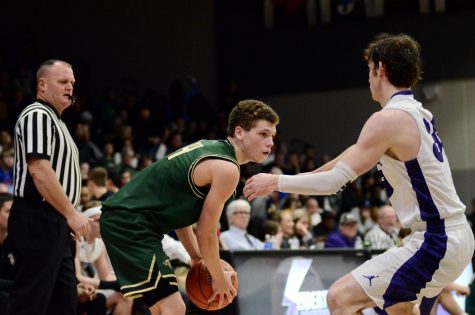
Nick Pepin ’20 keeps the ball away from Liberty during a double-header. Pepin transferred to West from Waterloo towards the end of his sophomore year.
Open enrollment
For students wishing to attend West High without changing their place of residence, things can become a little more complicated.
Open enrollment is defined by the Iowa Department of Education as “a cost-free option by which parents/guardians residing in an Iowa district may enroll their children into another Iowa school district.” Students who wish to open enroll must fill out an application detailing reasons for leaving the school district, which is sent to both the resident and receiving district’s superintendent.
If a student is approved to transfer without changing their place of residence, they are still ineligible for varsity athletic competition during the first 90 school days of enrollment at their new school. Assistant IAHSAA director Todd Tharp stresses the state’s prioritization of student’s education over athletics as reason for this restriction.
“To us they are students first, that’s the most important part,” Tharp said. “If they are out looking for a school, we encourage that it should be for academic reasons.”
The ineligibility requirement also deters athletes from transferring on a whim, insuring that any student transferring has a legitimate reason that outweighs the punishment of sitting for 90 days.
There is, however, a well-known loophole to this rule. For many athletes, avoiding the 90 day ineligibility period simply means transferring more than 90 days before the start of their athletic season.
Basketball player Even Brauns ’20 open enrolled at West in the spring of 2018 in order to be eligible for the start of the basketball season in the fall of 2018.
“[My parents] didn’t even know there was a rule about sitting out or anything. They called the athletic department, and then I had to transfer in like two days,” Brauns said. “We weren’t planning to transfer until after my sophomore year was over and then we found out and I literally had two days to leave and get enrolled here.”
Brauns, a recent University of Belmont commit, feels his decision to transfer to West from Regina is helping better prepare him for his college basketball career in the form of tougher competition and better talent development.
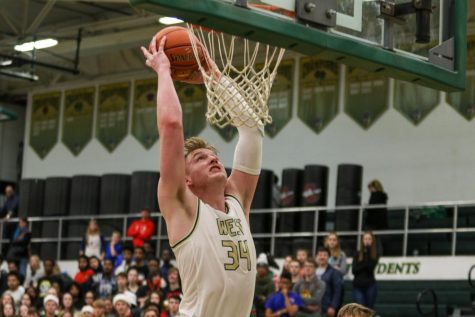
Even Brauns ’20 goes up for a dunk against Linn-Mar. Brauns open enrolled at West at the end of his sophomore year in order to be eligible for his junior and senior seasons.
“I just felt like I wasn’t improving [at Regina] the way I felt I should,” Brauns said. “My parents just felt like kids on my [club basketball] team were getting better during the high school season, and I was kind of staying the same.”
With the open enrollment system in Iowa, athletes, especially highly-touted prospects like Brauns, can be recruited to play for any program in the state. While outcries from parents and coaches have been directed at the IAHSAA regarding high school athletic recruitment, there is nothing stopping schools from recruiting student-athletes as outlined in the Iowa state code.
“There’s schools here in North Central Iowa that put great, big huge billboards in other school [districts] to say ‘Hey, come to our school.’ That happens all the time,” Tharp said. “Any high school in the state of Iowa can recruit.”
While there are no restrictions against recruiting, there are major penalties for any athletic programs found giving undue influence to student-athletes from other schools.
“[Undue influence is] more along the lines of saying … we’ll make sure we’ll get your parents both jobs, we’ll guarantee that you’re going to start for us,” Tharp said. “[Our focus] is not necessarily recruitment but more on undue influence.”
Tharp is fully aware of the apparent loophole within the open enrollment system, and personally calls for an extension of the ineligibility period to 180 school days, forcing athletes to sit out entire seasons before becoming eligible the following year.
“If it was a whole calendar year then [athletes] would have to sit out all of those sports, and you would see how serious and really bad it is for these transfers,” Tharp said. “I know there are some athletic directors around the state that have that sentiment, and I think they feel that would stop a lot of issues.”
Intradistrict transfers
While the state sets rules for athletes who transfer across school districts, those with multiple high schools are given the flexibility to adopt their own policy. As outlined in the IAHSAA’s General Transfer Rule, “A school district that has more than one high school in its district shall set its own eligibility policies regarding intradistrict transfers.”
Up until 2018, the ICCSD enacted harsher transfer policies than the state by requiring students who transferred between ICCSD high schools to sit out 180 days before competing in varsity athletics. Assistant ICCSD Superintendent Matt Degner and the rest of the secretary administrative team modified the rules last year to match the state’s policy of 90 days after recognizing the disadvantage for students transferring within the ICCSD.
“We just felt like that was a safer ground for us to be in,” Degner said. “In theory you would be punishing students in your own district a little bit more than kids coming from say Solon or West Branch. That didn’t feel right.”
While the state does not influence districts’ decisions on intradistrict transfer rules, most districts around the state adopt the 90 day policy to stay consistent when dealing with open enrollment.
“[The IAHSAA] gives them the local control to decide how they want to determine how student-athletes can move from school to school,” Tharp said. “I think it’s pretty consistent that all of [the districts] follow the same rules of the state for the 90-day ineligibility requirement.”
West has been the primary recipient of most of the ICCSD’s intradistrict transfers this year, with eight varsity athletes across five different sports transferring to West from Liberty.
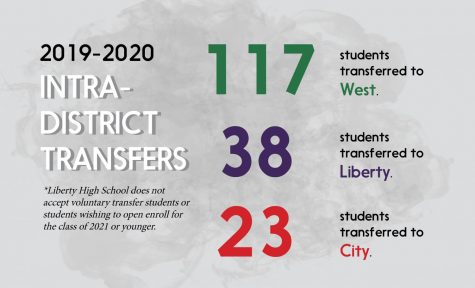
The volleyball team experienced a revolving door of transfers this year as they added Kearsten Lenth ’22 and Rylie Baldes ’21 from Liberty while also losing last year’s starting setter Rylee Fay ’20 to the Lightning.
While Lenth led the Women of Troy with 2.22 assists per set, Baldes was unable to compete this season due to the district’s policy regarding intradistrict transfers.
“It was tough sitting out the whole season, not being able to help on the court,” Baldes said. “I’m looking forward to being able to play and be a leader next season.”
For Fay, the decision to leave West High was not an easy one. Leaving friends and teammates behind was hard, but perhaps the biggest deterrent was the stigma that came with being labeled a ‘transfer.’
“I’ve seen the hate others had gotten for transferring, and I was scared that would happen to me,” Fay said.
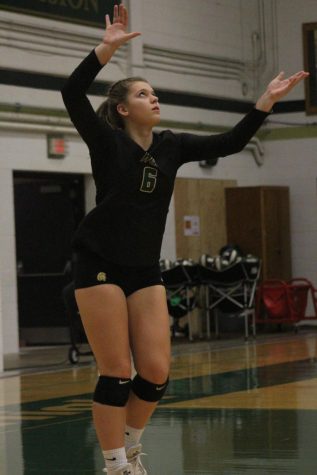
Rylee Fay ’20 serves the volleyball to Jefferson on Tuesday, Sep. 26 during her sophomore season. Fay compete for the Women of Troy until her junior year before transferring to Liberty for her senior season.
Aside from Liberty’s successful volleyball program, Fay also cited smaller class sizes and a familiarity with the Lighting’s head coach Randy Dolson, who coached her as a freshman at West, as reasons she made the switch.
“For those who didn’t know the real reasons and just assumed it was just for volleyball, there were many reasons why I [transferred],” Fay said. “Liberty was just a better fit for me.”
In the spring, boys soccer fans can expect a fresh face playing up top for the Trojans as Liberty transfer Kolby Godbolt ’21 works his way into the star-studded West lineup. Godbolt led the Lightning in goals scored and assists last season, but decided to transfer to West this year to better develop his skills in the hopes of playing collegiately in the future.
Godbolt initially intended to transfer during the middle of his sophomore year, but decided to wait until his junior year after realizing he would be forced to sit out for over half of the soccer season due to the district’s 90 day ineligibility requirement.
Similar to Fay, Godbolt felt some hostility from former teammates but feels this decision is best for both his soccer career and overall well-being.
“I think I just did what’s best for me,” Godbolt said. “Their opinion doesn’t really matter; I just wanted to be happy. I felt like West was a good fit for me, and I enjoyed being here.”
In the future
West has certainly benefited from transfer athletes in the past, and with growing knowledge of the process more student-athletes could be coming to play for the Trojans in the years to come.
“Nowadays people live in this information age where people know more. They know the policy and they know about individual schools and individual coaches,” West High athletic director Craig Huegel said. “We can’t do anything about the policy whether we like it or dislike it, but we try to provide the most positive experience possible for [our athletes].”
As more information about coaches and programs become available, parents seeking to find the best path to athletic success will inevitably begin scrambling for transfer requests to put their child in the best position possible.
While transferring for athletic purposes is nearly always permitted, and oftentimes warranted, Degner still feels the integrity of high school athletics would be better kept if students remained at their home schools unless absolutely necessary.
“Anytime you have a policy, there’s a spirit behind the policy. We don’t want the primary driver to change campuses to be around athletics,” Degner said. “We have full-slated athletic programs at every building, we have all kinds of extracurricular activities that we feel like if you’re changing campuses there should be a more compelling reason than just an athletic program.”

